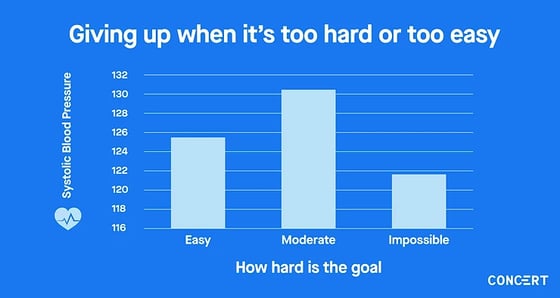The conventional wisdom around quotas seems to be once a rep hits a quota, they are rewarded with an even higher target. Research studies and our data show that’s wrong.
Like “The Dress” which took the internet by storm in 2015, it turns out that a quota being good or bad, achievable or not, is all a matter of perspective. (I still believe there’s a white and gold version of that dress out there!)
Psychologist Emily Balcetis’ research on an individual’s perception of their target and the direct influence on their motivation (what she refers to as “Approach” orientation), shows that perception impacts the likelihood of reaching that target. In short, there is a causal line between quotas and performance. We see this across human behavior and we have blogged about it before.
Her research has demonstrated that a more realistic (but not easy) target raises an individual’s systolic blood pressure, which is a physical representation of a body that is ready to move into action. Your quota directly impacts how ready someone is to work to achieve it.

In our own work, we’ve taken this to heart (ha!) and recommended that some of our prospects actually lower quotas and create additional intermediate targets. Early results support the case that more realistic targets can lead to improved performance. One company reduced quotas by 15% and that same team had a 15% increase in sales over the next three months.
The challenge is that perception of the target (and the likelihood of achieving it) is extremely individual. Yaacov Trope of New York University and Nira Liberman of Tel Aviv University studied this concept, which is known as psychological distance.
Psychological distance combines four components, each shaped by individual experience:
Spatial distance - the perception of the quantitative or physical gap
Temporal distance - the perception of the relationship between present and future
Experiential distance - the perception of the difference between imagination and experience
Social distance - the perception of ourselves in relation to others (management, prospects, peers)
Increasing quotas is an increase in the spatial distance, but also in the social distance between the rep and management. What was probably seen as a numerical budgeting exercise quickly becomes an exercise in demotivation.
What do you do if quotas have been raised?
In her Ted Talk, Balcetis says, "keep your eyes on the prize.”
Work to focus on and visualize the finish line. This makes the goal feel 30% closer (spatial distance), makes the process feel 17% easier (experiential distance), and increases speed by 23% (temporal distance). In short, focusing on your new quota (like, through real-time reporting!) will allow your brain to block out the reasons why you can’t achieve it and will make it feel closer.
It sounds like woo-woo magic, but our brains are incredibly capable of manipulating our perception to help us focus.

If you unfocus your eyes and point your gaze at the black dot in the middle of this image, you'll probably notice that, after a few seconds, the colors begin to disappear, one by one. This is called the Troxler effect. If you focus on one point, your eyes become desensitized to the surroundings and fade into the background.
In conclusion…
Before you or your management team raise quotas (and there may be legitimate reasons to do so that we’ll discuss next time), it’s critical to think beyond the spreadsheet and answer the following questions:
1. How are you changing the team’s psychological distance from your targets?
2. How will that increase motivation?
3. What are we doing to help shorten those distances?
Learn more on how to help your team hit quota every time with our article on Sales Motivation: 5 Tips to Hit Quotas.




